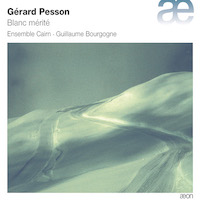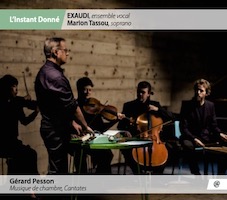An Appreciation of Recent Pesson: “Graceless Anticipations”
|
Grant Chu Covell [August 2022.] “Composing is nothing other than prolonging the work of listening.”
“Blanc mérité.” Gérard PESSON: Carmagnole (2015)1; Six selections from Musica ficta (2002-present)2; Ne pas oublier coq rouge dans jour craquelé (2010)3; Six transformations du menuet K. 355 de Mozart (2008-11)4; Neige bagatelle (2002)5; Blanc mérité (avec Roman Opalka) (2017)6. Ensemble Cairn: Cédric Jullion1,4,6 (fl), Ayumi Mori1,4,6 (clar), Clément Himbert6 (sax), Matthias Champon6 (tpt), Caroline Cren1,2,3,4,5 (pno), Christelle Séry1,4,5 (guit), Fanny Vicens1,6 (accordion), Naaman Sluchin1,4, Alexandra Greffin-Klein3, Eun Joo Lee6 (vln), Cécile Brossard1,2,6 (vla), Ingrid Schoenlaub4,6, Frédéric Baldassare1,3,5 (vlc), Guillaume Bourgogne1,6 (cond.). Aeon AECD 1649 (1 CD) (www.outhere-music.com). “Musique de chambre, Cantates.” Gérard PESSON: La lumière n’a pas de bras pour nous porter (1994)1; Cassation (2003)2; Rébus (1999)3; Cinq chansons, Marie Redonnet (1999)4; Bruissant divisé (1998)5; La vita è come l’albero di Natale (1992)6; Étant l’arrière-son (2011)7; In nomine / John Taverner (2001)8; Instant tonné (2006)9; La lumière n’a pas de bras pour nous porter (1994; orch. Frédéric PATTAR, 2006)10; Cantate égale pays (2010)11. Marion Tassou4 (sop), L’Instant Donné: Cédric Jullion3,4,7,8,9,10,11 (fl), Philippe Régana8,9,10,11 (ob), Mathieu Steffanus2,3,4,7,8,9,10,11 (clar), Caroline Cren1,2,4,6,8,9,10,11 (pno), Maxime Echardour8,9,10,11 (perc), Esther Kubiez-Davoust7,10,11 (hrp), Saori Furukawa2,3,5,6,7,8,9,10,11 (vln), Elsa Balas2,3,4,8,9,10,11 (vla), Nicolas Carpentier2,3,4,5,7,8,9,10,11 (vlc), Ensemble vocal EXAUDI11: Juliet Fraser, Amanda Morrison (sop), Tom Williams (c-ten), David de Winter, Jonathan Bungard (ten), Francis Brett (bar), James Weeks (dir.), Grégory Beller11, Luca Bagnoli11 (electronics). NoMadMusic NMM052 (2 CDs) (www.nomadmusic.fr). I want to describe Pesson’s wonderful music with pretentious non-musical phrases: quivering and febrile, like rustling leaves, or something nearly forgotten played in the next room, etc. There are at least two reasons for this: Pesson’s music is inherently thick with extra-musical associations from the start, and his creative efficiency and technique quickly orient the ear towards musical associations and references. Other composers make do with note values and pitches, whereas Pesson immediately alights upon connotations and an expressive plateau. The alluring titles play their part, but most importantly Pesson’s compositions demonstrate outstanding craft. A glance at Aeon’s program references people (Giuseppe Penone, Jean Genet, Marcel Proust, Roman Opalka) and composers (Verdi, Alkan, Chopin, Mozart, Messiaen). Without hearing a note, we have plenty of references to orient ourselves, but we are immersed in European culture. The NoMadMusic twofer readily name-checks composer John Taverner and the poets Marie Redonnet, Mathieu Nuss, Gerard Manley Hopkins and Elena Andreyev (who may be more familiar as a cellist). Allusions aside, you will hear ensembles performing energetically, responsive to Pesson’s talent. These two releases (Aeon from 2017, NoMadMusic from 2018) offer seventeen pieces. Or more if the three cantatas in Cantate égale pays are considered separately or if the excerpts from Musica ficta, the progressive collection of piano pieces (for one, two or three pianos, but sometimes with just one hand), are counted individually. The shortest pieces can be just a few minutes. They may have poetic titles: La lumière n’a pas de bras pour nous porter (“Light has no arms to carry us”) or La vita è come l’albero di Natale (“Life is like a Christmas tree”). Pesson’s titles can be enigmatic: Bruissant divisé (“Rustling divided”) or simply obscure: Carmagnole, Cassation or Musica ficta. In another place I introduced Pesson (b. 1958) as “the Französisch Lachenmann.” This is because, like Lachenmann, Pesson demonstrates a fluency with non-standard sounds: tapping, scraping, playing stringed instruments on the “wrong” side of the bow or bridge, blowing soundlessly through wind instruments, plucking the piano interior, etc. In Pesson’s music these unfamiliar sounds are not gimmicks. One of Pesson’s mundanely titled pieces, Six transformations du menuet K. 355 de Mozart, is a good entry point into his working methods and aesthetic. Scored for flute, clarinet, piano, percussion, guitar and string trio, there are six variations on K. 355, including the first, despite it being titled Original. As Webern introduced us to a faceted Bach, so does Pesson disguise and splinter. The series gently dissolves the minuet, alluding to other places (“Tyrolienne”) and styles (“À la manière d’Olivier Messiaen”). Pesson created a total of 27 Mozart variations, encompassing solos and choir pieces. La lumière n’a pas de bras pour nous porter is just under four minutes for piano solo, a homage to composer Dominique Troncin who died in 1994 at 33. There are not a lot of pitches, in fact, only the white-note keys, and most from the keyboard’s upper half. The prominent sounds are fingers and fingernails strumming the sides of the ivories, knocking on the case, eliciting a perky waltz rhythm. Pesson’s piano is gently percussive, the piece is eerie, energetic and melancholy. Years later, Frédéric Pattar orchestrated La lumière. This seems an impossibility: How could something so fragile be expanded across more players? The thing is, Pesson’s original embodies great tension that an enlargement is not inconceivable. The notes inform us: “…Pesson maintains that the ‘real original is now the Pattar version; its previous version for piano (much too) solo is nothing but a graceless anticipation.’” Among the shorter pieces: Bruissant divisé (violin, cello) brings to life a bit of Proust’s imagined Sonata by Vinteuil. Violon and cello (Saori Furukawa and Nicolas Carpentier) are equal whispering partners with four hands across eight strings. La vita è come l’albero di Natale (violin, piano) considers a bit of Debussy but veers towards a comparable piece by Franck. Neige bagatelle (guitar, cello, piano) was written for a concert given on February 20, 2002 at 8:02pm (in European format: 20/02/2002 20:02). The event’s theme was palindromes and included older works (Bach, Haydn) and new ones. Proust returns in the piano trio Ne pas oublier coq rouge dans jour craquelé (“Do not forget – red cockerel in cracked daylight”), six moments which respond to extracts from Proust’s notebooks. Rébus’s fuller title is Rébus (Pro Rebus Harry Vogti) sur le cantus firmus In Nomine. At under two minutes the 54 pitches of the In Nomine cantus firmus from John Taverner’s mass are distributed across flute, clarinet, violin, viola and cello. Contrasting other compositions, we hear conventional pitches and trills. Later in its program, L’Instant Donné provides Pesson’s instrumentation of Taverner. The short piece whose title puns upon the ensemble it honors, Instant tonné, is a type of 18th-century licenza, a homage to a person, function or institution. Only the white notes appear, as well as thunder sheets. Invoking the god of thunder was a way to ensure that future storms would evolve into beauty. Among the longer pieces are Carmagnole, a wild rattling dance for flute, clarinet, piano, percussion, guitar and string trio. The title refers to a song popular during the French Revolution which presumably lies embedded somewhere in these thirteen minutes. The players are grouped: the two winds, the string trio, the piano, guitar and percussion. Associations are proposed then rebuffed, non-pitched rhythms are emphasized. Rustic Carmagnole’s opposite could be Blanc mérité (“Well-earned white”). The ensemble (a leading saxophone supported with flute, clarinet, trumpet, accordion and string trio) may utilize similar sounds, but unity is less essential: the sax may ride on a plucked instrument’s wake, a stringed instrument may knock once instead of repeatedly. Pesson considers the paintings of Roman Opalka who progressively used more and more white pigment while painting a continually increasing number series. A minimalist like Tom Johnson might be more appropriate to reflect upon Opalka, but Pesson looks closely at the materials and conjugates diversity across the underlying series. The last section grows progressively higher, practically inaudible. In Cassation (clarinet, violin, viola, cello, piano) the trio is predominantly strummed (sometimes with guitar picks), the piano concentrates on the interior or is muffled, and most melodic attempts are given to the clarinet. Maybe the Wagner quotations will be audible. The title is an infrequent alternate for “Divertimento” (Mozart wrote a few). At 18 minutes the scale is leisurely, hardly imposing. Pesson’s magic is to make many musicians working together sounding feather light in an extension of Klangfarbenmelodie. In some pieces it’s because he’s crafted a single ornamented line which is draped across all players, intentionally dispensing pitched and non-pitched effects. Melody and accompaniment are suspended. This is visible in the Cinq chansons where the ensemble (flute, clarinet, viola, cello, piano) behaves as one as it responds to the mezzo-soprano, an agile Marion Tassou. Pesson’s settings are clear and crisp, even if the texts are opaque, we are still meant to hear them. This technique also appears in Étant l’arrière-son, where a modest ensemble (flute, clarinet, harp, violin, cello) maneuvers in unison, suspending the nimblest line. Perhaps Pesson’s creations are actually musical caricatures. There is comedy in the rapid alternation of a screaming clarinet, the topmost piano keys rattling, a violin harmonic, and an unidentifiable scrape. Pesson’s motivic gestures are not distant from Pierrot Lunaire or Chansons Madecasses. The composer has said: “There is music behind all music,” which fits well for an adept impersonator. We should not be surprised when Pesson turns serious. If this chamber music assortment tends to whisper, the cantatas confidently insinuate. No. 1, Jachère aidant (“Fallow-field rescue”) spills out in sixteen tiny movements thick with activity. Texts are by Mathieu Nuss, a modern reaction, perhaps to the four poems of Gerard Manley Hopkins in No. 2, “God’s Grandeur.” The second cantata is most conventional with longer settings and clear recitatives. Pesson likens No. 1 to a storyboard, a quick sketch, hot with reactions. No. 3, Gd Mmré (“Great Murmur(ed)”) may be the most theatrical and hardest of the three recordings to understand. Elena Andreyev’s text is cut and reassembled, words and syllables appropriated by electronics which repeat and confuse. Mostly in French, occasional English may briefly jolt (“…most juicy fancy…”). No. 3 is restless and energetic, a distant cousin by accident or serendipity to Aperghis. The initially tispy fusion of voices can grow bewildering. The electronics camp at the edges and are not meant to be spatialized or predominant, but to appear as if a sound effect. There are birds and I hear church bells and a barking dog, but these could just as well be outside the live performance itself. No. 3 emphasizes actors who have pre-recorded texts. All the performances are exemplary. Aeon collects tapings from March 2014, April 2015 and May 2017; NoMadMusic’s recordings are from March and April 2016 (Pierre Henry is listed as an assistant recording and mixing engineer!). Flutist Cédric Jullion and pianist Caroline Cren are common to both. Ensemble Cairn and L’Instant Donné work at a high level: This is chamber music at its best. Ensemble Cairn gave the first performances of Carmagnole and Blanc mérité (and the orchestrated version of La lumière n’a pas de bras pour nous porter). L’Instant Donné premiered Étant l’arrière-son, Instant Tonné and Cantate égale pays. (The NoMadMusic cover shows Pesson standing at a typewriter, which I suspect is from a piece not offered here.)
[More Grant Chu Covell]
[Previous Article:
EA Bucket 33.]
[Next Article:
Used Bin Troll Tweets JJJ.]
|

